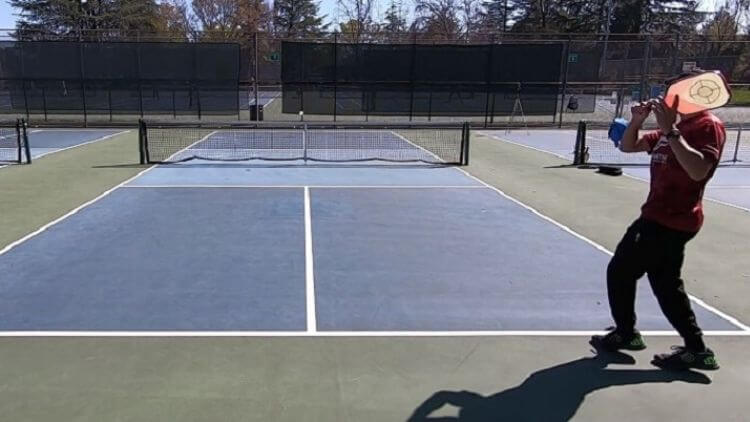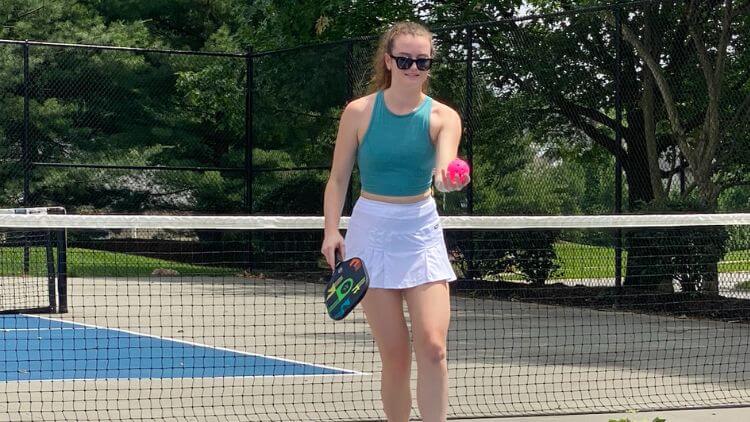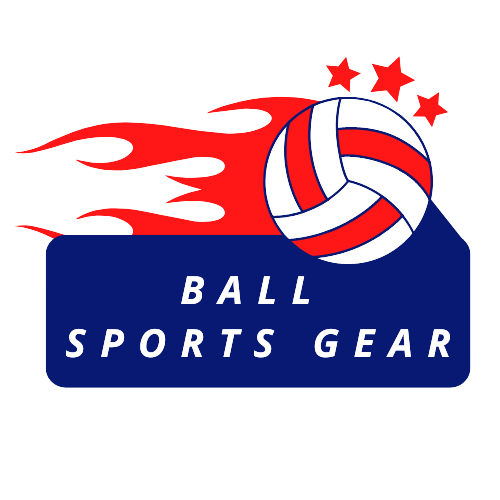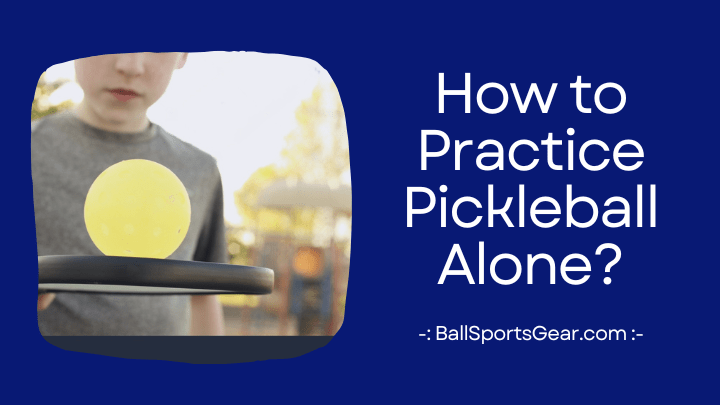Practicing pickleball alone is an excellent way to sharpen your skills and improve your game, even when you don’t have a partner available. While playing with others is fun, solo practice allows you to focus on specific aspects of your game and develop a strong foundation. In this article, we will explore how to practice pickleball alone and its various techniques and strategies that will help you maximize your practice sessions and elevate your pickleball skills, all on your own.
How to Practice Pickleball Alone?
Setting Up the Practice Space:
To begin practicing alone, you need to find a suitable area that closely resembles a pickleball court. Whether it’s a dedicated pickleball court, a tennis court with pickleball lines, or a marked-out area in your driveway, ensure that the dimensions are accurate and the playing surface is appropriate.
Warm-Up Exercises and Stretches:
Before starting your solo practice, warm up your body with some dynamic stretches and light exercises. This will help prevent injuries and prepare your muscles for the physical demands of pickleball. Incorporate movements that engage your entire body, including shoulder rolls, arm circles, lunges, and light jogging.
Incorporating Targets and Challenges:
Add an element of challenge to your solo practice by incorporating targets or creating specific goals. Use cones, markers, or tape to designate areas on the court as targets for shot placement. Challenge yourself to hit the targets consistently or to execute a specific shot pattern. This will enhance your accuracy, decision-making, and overall game control.
Mental Practice and Visualization:
Mental preparation is a crucial aspect of pickleball. During your solo practice sessions, take some time to visualize game scenarios and strategies. Imagine yourself in a match situation and practice decision-making and shot selection in your mind. This technique can help improve your anticipation, focus, and overall mental game.
Recording and Analyzing Practice Sessions:
Consider recording your solo practice sessions to analyze your technique and identify areas for improvement. Use a smartphone or camera to capture your drills and review the footage later. Pay attention to your footwork, body positioning, swing mechanics, and shot execution. Self-analysis will help you identify strengths, weaknesses, and areas that need refinement.
Drills to Practice Alone
Wall Dinks and Volley:
When you’re practicing alone, a wall can become your best training partner. Stand a few feet away from the wall and practice dinking and volleying against it. Focus on your hand-eye coordination, control, and shot placement. This drill will help you improve your touch and precision.

Serving Accuracy:
How to practice pickleball serves alone? Serving is a critical aspect of pickleball. Set up a target on the court or draw a specific area using chalk. Practice serving and aim to hit the target consistently. Experiment with different serves, such as the lob serve, drive serve, or cross-court serve, to enhance your repertoire.
Shadiness Footwork:
Footwork plays a crucial role in pickleball, and practicing it alone can greatly improve your agility and movement on the court. Stand in front of a mirror or an imaginary opponent and simulate game situations. Focus on your footwork, positioning, and balance. This drill will help you develop quicker reflexes and better court coverage.
Mini-Court Drills:
Create a smaller playing area using cones or markers to simulate a mini court. Practice groundstrokes, volleys, and dinks within this confined space. This drill will help you improve shot accuracy and control, as well as simulate game scenarios where precise placement is crucial.
Solo Rally:
Stand on one side of the net and hit the ball to the other side, allowing it to rebound back to you. Keep the rally going, alternating between forehand and backhand shots. This drill will help you improve your consistency, timing, and shot selection.
Agility and Conditioning:
Incorporate agility drills into your solo practice sessions to improve your speed and endurance. Set up cones or markers in different patterns and practice quick movements, side shuffles, diagonal sprints, and directional changes. This will enhance your on-court mobility and overall fitness.
Wall Drills:
Find a flat wall and stand at a distance that allows you to comfortably hit the ball against it. Practice your forehand and backhand strokes, focusing on maintaining control, accuracy, and consistent contact with the ball. Vary the speed and placement of your shots to simulate real game situations.
Serving Practice:
Serving is a critical aspect of pickleball. Utilize your practice space to work on your serves. Aim for consistency and accuracy by practicing various types of serves, such as the underhand serve, drive serve, or lob serve. Set targets on the court to enhance your precision.
Dinking Practice:
Dinking is a delicate and strategic shot in pickleball. Use a wall or a rebounder to practice your dinking skills. Focus on softening your grip, maintaining a low and compact swing, and controlling the ball’s placement near the net. This drill will improve your touch and control during close net exchanges.
Groundstroke Drills:
Set up targets or use lines on the court to practice your groundstrokes. Work on shot placement, power, and consistency. Incorporate both forehand and backhand strokes into your drill routine, varying the depth and angle of your shots.
Volleys and Overheads:
For volleys and overhead shots, utilize a rebounder or wall. Practice your footwork, timing, and shot execution. Aim for clean and crisp volleys while maintaining stability and control during overhead shots.
Equipments to practice alone
Portable Pickleball Practice Net:
Setting up a portable pickleball practice net is a great way to create a designated practice area. These nets are lightweight, easy to assemble, and can be adjusted to the standard pickleball net height. With a practice net, you can focus on serving, hitting, and perfecting your shots without the need for a partner.
Pickleball Ball Machine:
Investing in a pickleball ball machine can significantly enhance your solo practice sessions. These machines are designed to simulate game-like situations by launching balls at varying speeds, angles, and trajectories. With adjustable settings, you can customize the drills to target specific areas of your game, such as volleys, groundstrokes, or overhead shots.
Wall or Rebounder:
Utilizing a wall or a rebounder is a cost-effective way to practice alone. Find a suitable wall with enough space and mark the pickleball court dimensions using tape or chalk. You can then practice your shots by hitting the ball against the wall, working on your hand-eye coordination, control, and shot placement.

Training Tools:
Several training tools are available in the market that can assist you in practicing alone. Dinking paddles, for example, are designed to improve touch and control during close net exchanges. Agility cones can be used to set up drills to enhance footwork, speed, and agility. These training aids provide targeted practice opportunities and can be easily incorporated into your solo training routine.
Frequently Asked Questions
A: To practice alone, you can utilize equipment such as a portable pickleball practice net, a pickleball ball machine, a wall or rebounder, and training tools like dinking paddles and agility cones.
A: You can set up a practice area at home by identifying a suitable space, ensuring the proper court dimensions and markings, and assembling a portable pickleball practice net. You may also need to mark the court boundaries using tape or chalk.
A: There are various drills you can do when practicing alone, including wall drills for hand-eye coordination, serving practice for accuracy, dinking against a wall for touch and control, groundstroke drills for shot placement, and volleys and overheads against a rebounder or wall.
A: You can make your solo practice sessions more challenging by incorporating targets on the court for precision practice, creating challenges for accuracy and speed, and setting goals to track your progress and push yourself to improve.
A: Yes, there are online resources such as tutorials, instructional videos, and virtual training programs that provide guidance and tips for practicing pickleball alone. You can also join pickleball communities and forums to connect with other players and seek advice.
Conclusion
Practicing pickleball alone may seem challenging at first, but with the right mindset and techniques, it can be a rewarding experience. By utilizing portable practice nets, ball machines, walls or rebounders, and training tools, you can create a conducive environment for solo practice. Remember to set goals, track your progress, and stay motivated throughout your journey. With dedication and consistent practice, you’ll witness significant improvements in your pickleball game. So, grab your equipment and embrace the opportunity to take your skills to new heights through solo pickleball practice.

